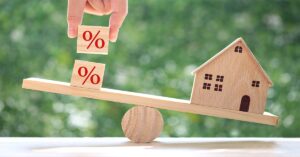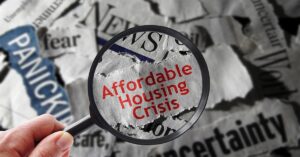Homeownership rates for the LGBT community lag behind the rest of the U.S. population, according to a survey last year from Freddie Mac. Only 49% of LGBT households own their own homes, less than the 64% national rate.
Is that changing after the landmark Supreme Court ruling in 2015 that permitted same-sex marriage nationwide? The same Freddie Mac survey found that 73% of LGBT couples who are married own their home, compared with 41% of nonmarried LGBT couples and 35% of singles.
“Same-sex marriage is still new in our culture,” says Jeff Berger, founder of The National Association of Gay and Lesbian Real Estate Professionals (NAGLREP). “I think there was pent-up demand when same-sex marriage became legal. Years ago, people weren’t thinking, ‘When I grow up, I want to buy a home and raise a family.’ Now it’s more natural.
With same-sex marriage legal nationwide, it stands to reason that more LGBT couples are buying homes. But it’s not that clear-cut. The annual American Community Survey from the U.S. Census Bureau found the percentage of same-sex couples that own their homes remained steady prior to and after the court ruling.
There were 783,100 couples who identified as same-sex in the U.S. in 2014 and 66.9% reported they owned their homes. In 2017, 935,229 couples identified as same-sex, both married and unmarried, and 66.2% said they owned their homes, or slightly lower than three years earlier. (The percentage for opposite-sex couples was 79.8%.)
Same-sex marriage is still new in our culture. I think there was pent-up demand when same-sex marriage became legal.
A study released in 2016 and conducted when gay marriage was permitted in only a limited number of states took up the question of whether the legalization of same-sex marriage affects LGBT home purchases. The study by the U.S. Department of Housing and Urban Development estimated an increase of 8% to 13% in same-sex mortgage applications after the policy change.
A NAGLREP survey from this past February found that 55% of the association’s membership of real estate agents, mortgage brokers and other professionals believe that more same-sex couples are buying now that marriage is legal nationwide. That’s up from 46% in a similar survey only two years earlier.
Still, that means that a significant number of housing-industry professionals felt that the court’s ruling has not increased homeownership in the LGBT community. Kimber White falls into this category. White is the president-elect for the National Association of Mortgage Brokers (NAMB) and a member of NAGLREP.
White, who says he was expressing his own opinion — not that of NAMB — believes discrimination plays both a real and perceived role in discouraging LGBT homeownership. He says actual discrimination may occur in a small number of cases, but LGBT couples, especially those in rural areas, may not even go through the process of purchasing a home.
“I’ve lived my life as ‘perception is reality,’” White says. “That’s my motto. If someone perceives something, then that’s still reality. It’s our job to prove them wrong and it’s our job to make a corrective move.”
He’s not the only one who feels this way. Fifty-nine percent of the respondents to this year’s NAGLREP survey say they felt the fear of discrimination during the purchase process discouraged homeownership in the LGBT community. LGBT clients in the survey also worried they were not getting the lowest available mortgage rates, would not be approved for a mortgage due to their sexual orientation and were nervous about how welcoming their future neighbors would be.
NAGLREP is advocating for the Equality Act, a bill that would prohibit discrimination based on sex, sexual orientation or gender identity in housing, the workplace, public accommodations and other settings. The bill was approved by the Democrat-controlled House of Representatives earlier this year. It hadn’t moved forward in the Republican-controlled Senate as of this past September. The Equality Act is needed, Berger says.
“I always use this analogy as a kind of a joke: People don’t refrain from robbing banks because of morality,” Berger says. “They refrain from robbing banks because they face jail time or the prospect of getting in trouble.”
Berger says there are other reasons why the LGBT homeownership rate is lower than the national average. He pointed out that higher percentages of LGBT populations live in urban areas instead of rural areas.
“Take a city like Washington, D.C., San Francisco or New York City, for example,” he says. “The price of homes is very high. There’s going to be more renters.”
The National Association of Realtors (NAR) randomly surveys homebuyers each year. After the Supreme Court ruling, NAR began asking questions about sexual orientation. This year, NAR released its first report on lesbian, gay and bisexual (LGB) homebuyers. The survey didn’t include information about transgender buyers, since that is question of gender identity rather than sexual orientation, but the association plans to compile this data in future studies.
The study found that the share of LGB homebuyers was about 4%, or roughly the same percentage of the U.S. population who identify themselves as LGB in Gallup polls, says Jessica Lautz, NAR’s vice president of demographic and behavioral insights.
One of the things that surprised Lautz about the survey results is that the LGB population isn’t homogenous. NAR found that lesbian and gay homebuyers are older than those who identified as bisexual, with average ages of 44 and 36, respectively. Bisexual buyers also were more likely to identify as Hispanic and to be single mothers.
One way to reach this population is through organizations such as NAGLREP, which was founded in 2007 and has 37 local chapters and more than 2,500 members. About 85% of its membership is LGBT, while about 15% identify as heterosexual. Berger notes that NAGLREP has a member directory used by the LGBT community.
“So, mortgage professionals can engage with our local chapters and get in front of our real estate professionals,” Berger says. “That’s how many of them are excelling.”






